How does vision work? How does sound arrive to our ears? And how can one visualize these sensory perceptions convincingly to a diverse readership, that might see and hear things differently? These questions became increasingly pertinent in the early modern period. With the introduction of instruments such as the microscope and telescope, the senses were transformed and reconfigured. And under the influence of growing skepticism, the senses as reliable transmitters of knowledge were increasingly questioned. At the same time, naturalists and experimenters emphasized that their findings were observed by their eyes or by their ears. This late eighteenth-century architectural dictionary, for example, included a so-called “perspectival pantograph,” by which one could draw “with speed and precision.” The instrument is positioned between the object and the observer, guiding the viewers’ eyes and hands. According to the author, this device eliminated the need for geometrical methods of drawing perspective. This section of the exhibition focuses on images that depict the process of hearing and seeing and how fleeting sensory perceptions and observations could be turned into a more material object on paper.
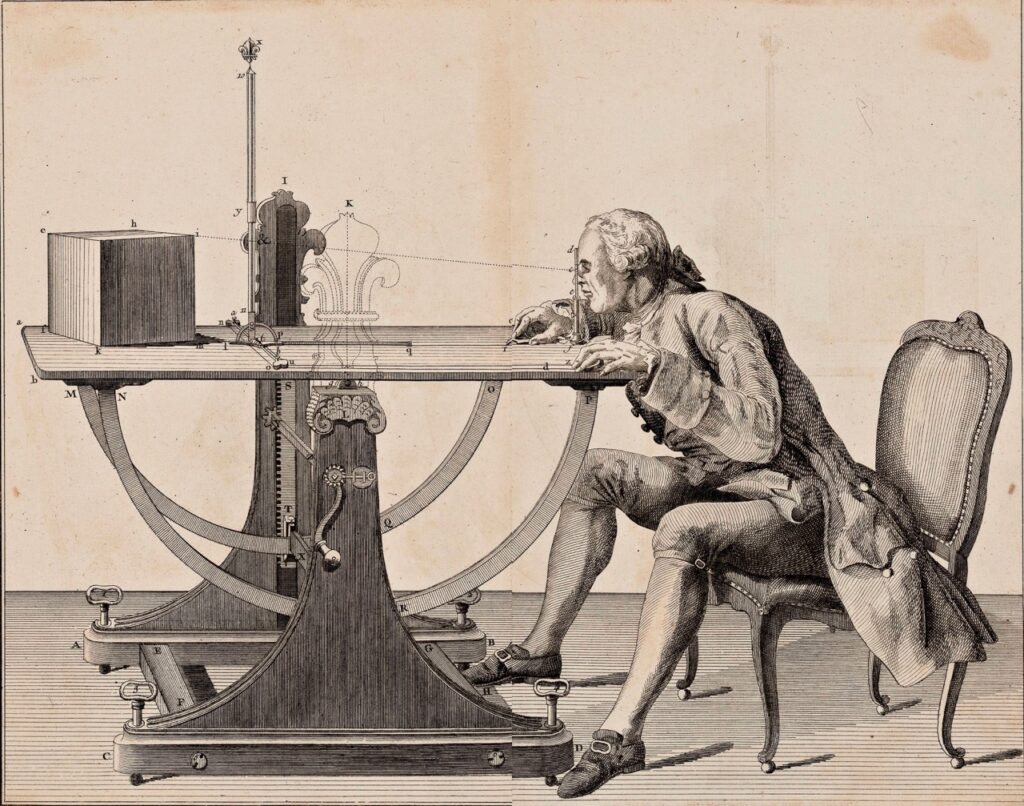
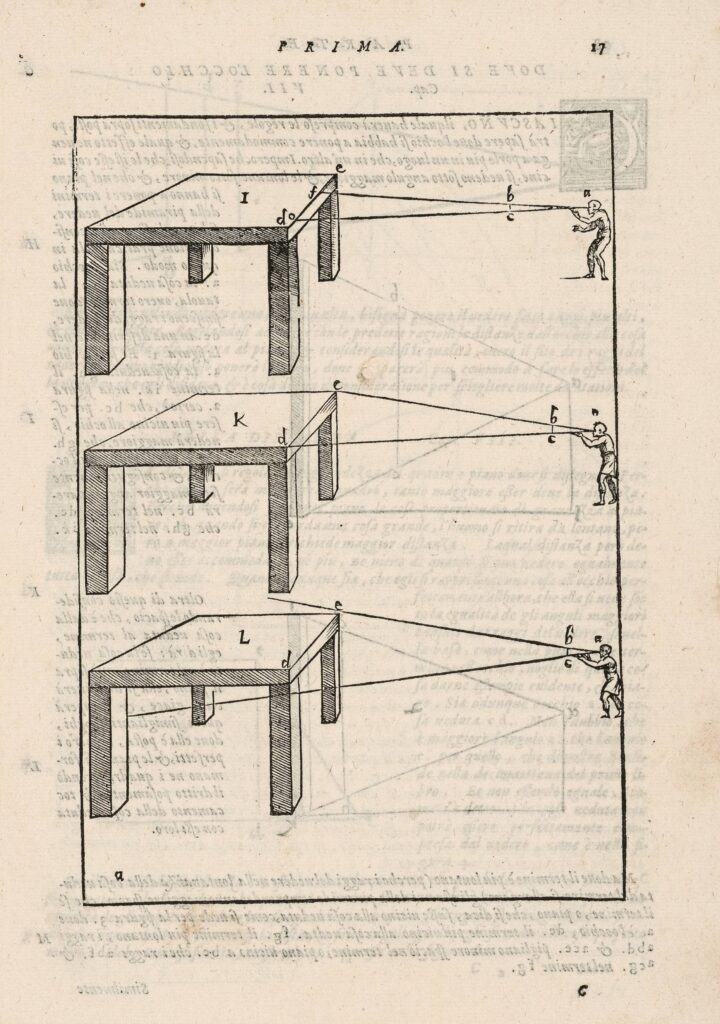
All vision proceeds by straight lines, Daniele Barbaro declared in his La pratica della perspettiva printed in Venice in 1569. According to him seeing happens in the shape of a pyramid with the eye as apex, seen here on the right. Through this principle, Barbaro was able to explain how under certain angles, things appear equal or unequal.
Throughout his text he is interested in making these geometrical principles palpable and visible, for example by holding a measuring stick before one’s eyes at different distances, as is depicted here.
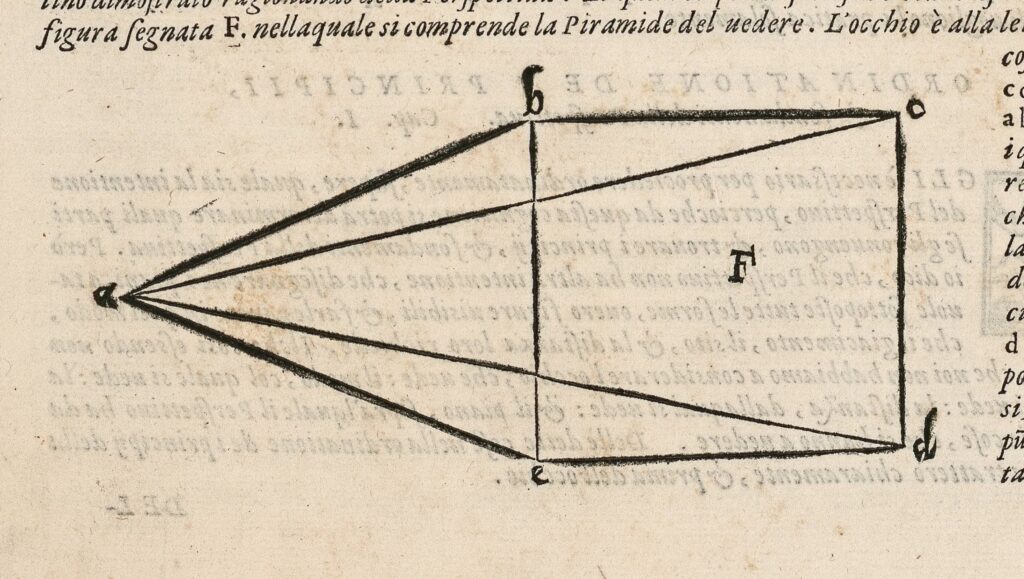
Barbaro’s text already contained an interest in anamorphic images (images that have been distorted in some way), something that is continued in Jean-François Niceron’s Perspective curieuse from 1638. The book contains all kinds of optical tricks and games, especially related to anamorphic images. In this engraving, the original image is stretched out into a circle. By placing a metal tube that acts as a mirror, the viewer obtains the original image. Niceron’s examples included saints, portraits, and popes, allowing the viewers to see how recognizable figures can be distorted and made visible again.
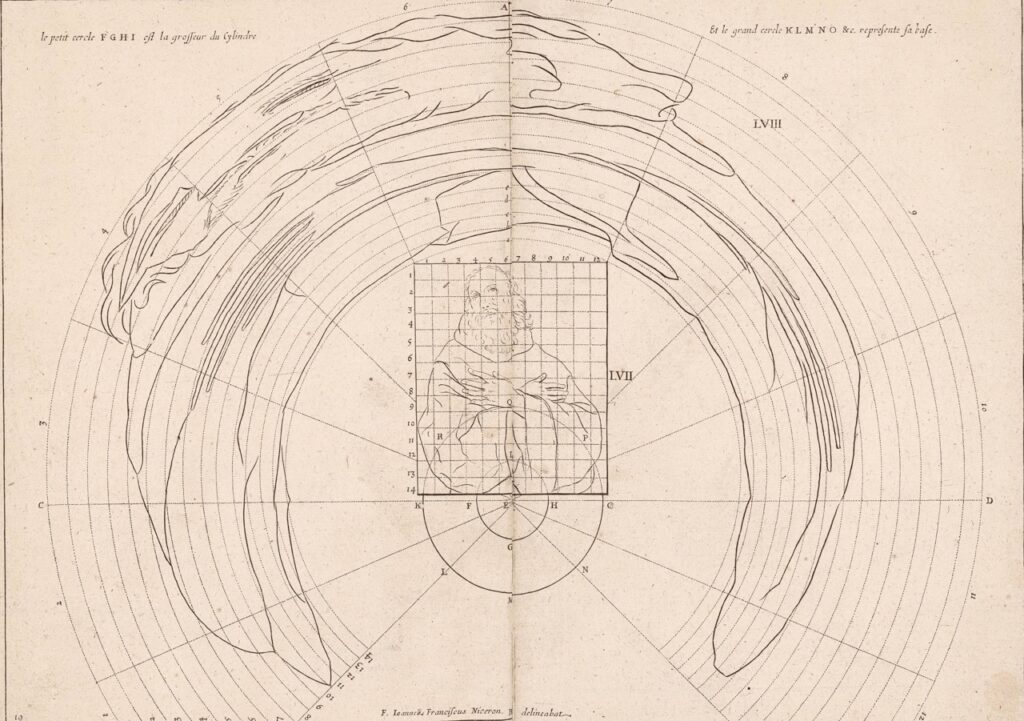
These tricks are also displayed on the frontispiece of his book, which depicts several putti instructing each other in the art and science of perspective. The experiment of placing a metal tube in order to show the distorted (anamorphic) portrait is depicted on the right. This time, it is not a Christ-like figure but a nobleman. As the putti on the frontispiece make clear, Niceron’s book can be seen as a visual education on how to look at images.
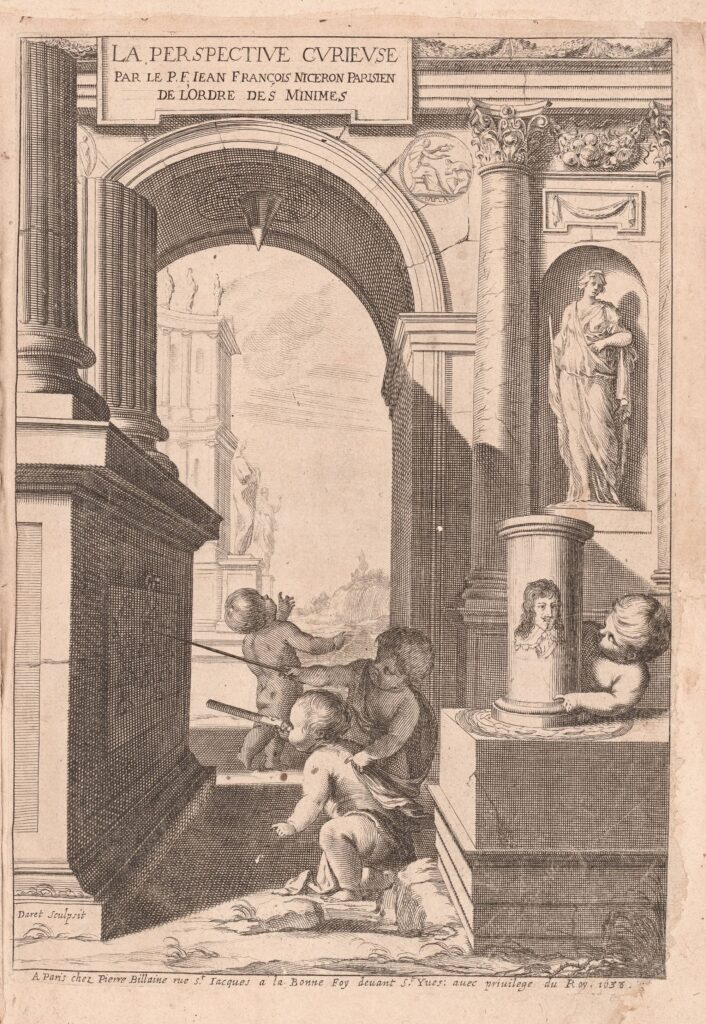
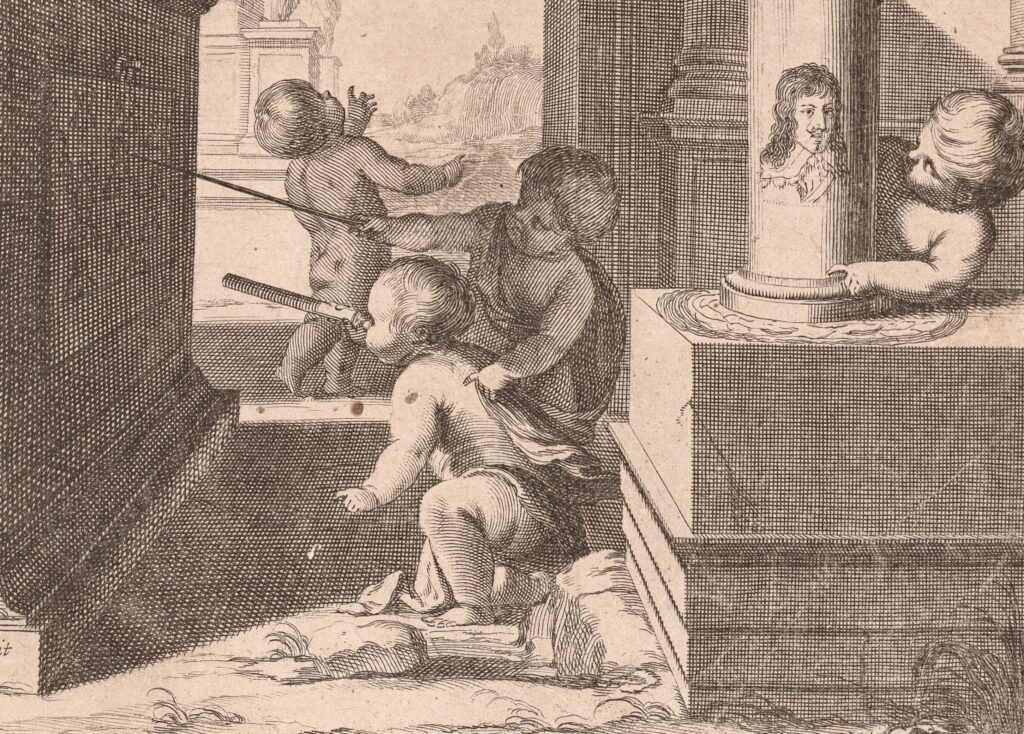
The German engraver Joachim von Sandrart also dealt with the ways in which perspective could be used to create images. Sandrart retold the story of the discovery of drawing in this engraving. As he explained in the accompanying text, the first painters were shepherds who drew lines in the sand around their shadow, depicted above. The scene at the bottom of the image is the story of Kora of Scicyon, who drew the outlines of her lover’s shadow on the wall. With these two scenes, Sandrart depicted the origin of the pictorial arts and provided its rationale, namely the imitation of nature. At the same time, Sandrart’s engraving shows how one can make sense of what one sees, giving material form to the ephemeral.
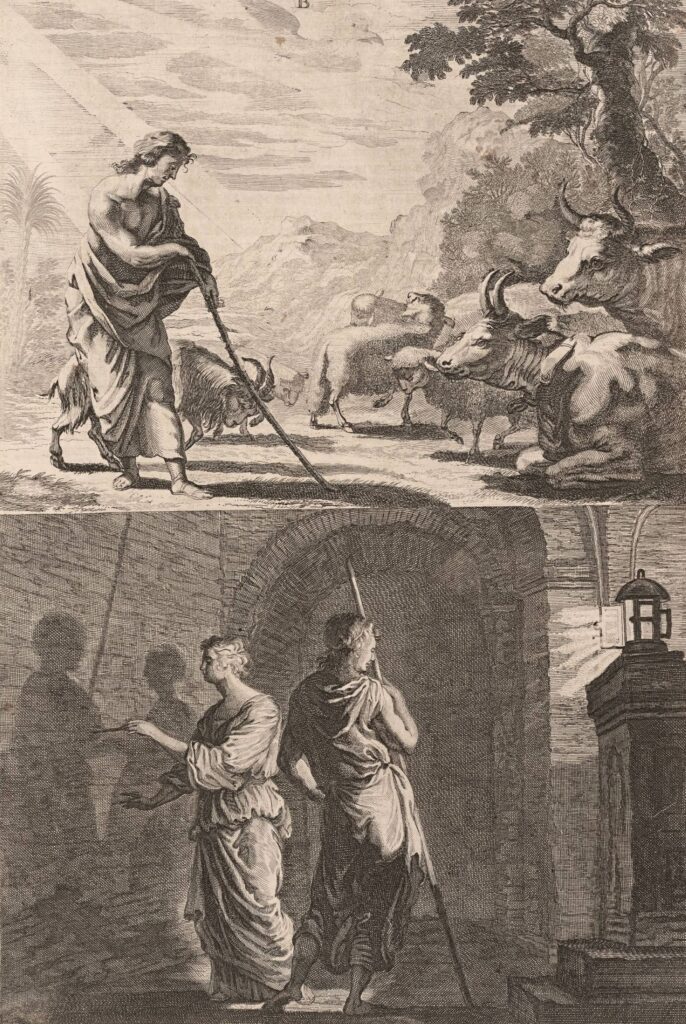
Inspired by geometrical theories in the study of light, Athanasius Kircher adopted optical theorems to study and depict sound. Instead of mirrors and lenses that would break or reflect light, the tools to investigate echoes were ruins and theaters that returned sounds to the observer.
Reading the page from the top left to bottom right, Kircher’s echoes become increasingly complex and his visualizations more and more abstract, until ultimately the male figure has been reduced to a point (A) and only geometrical lines are left.
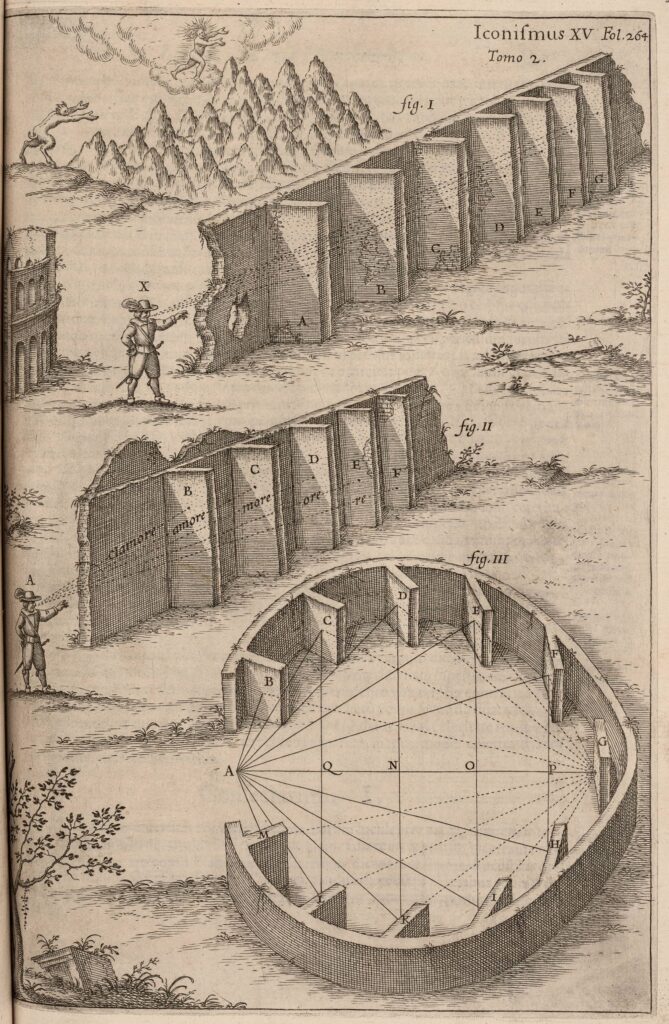
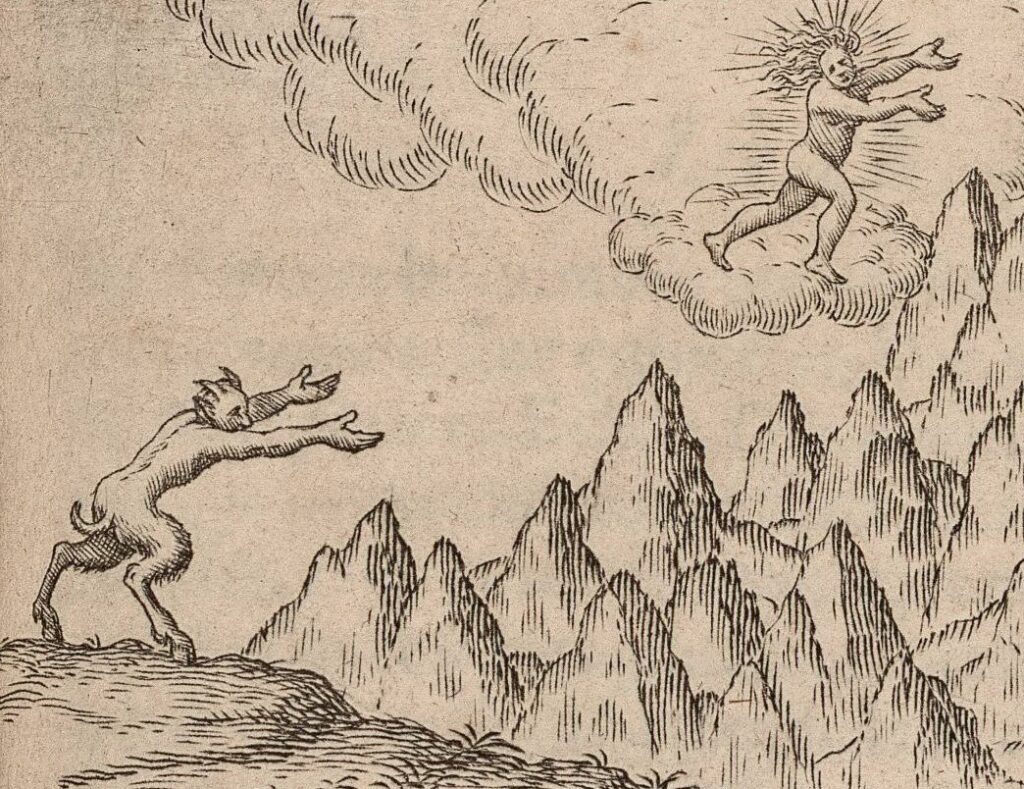
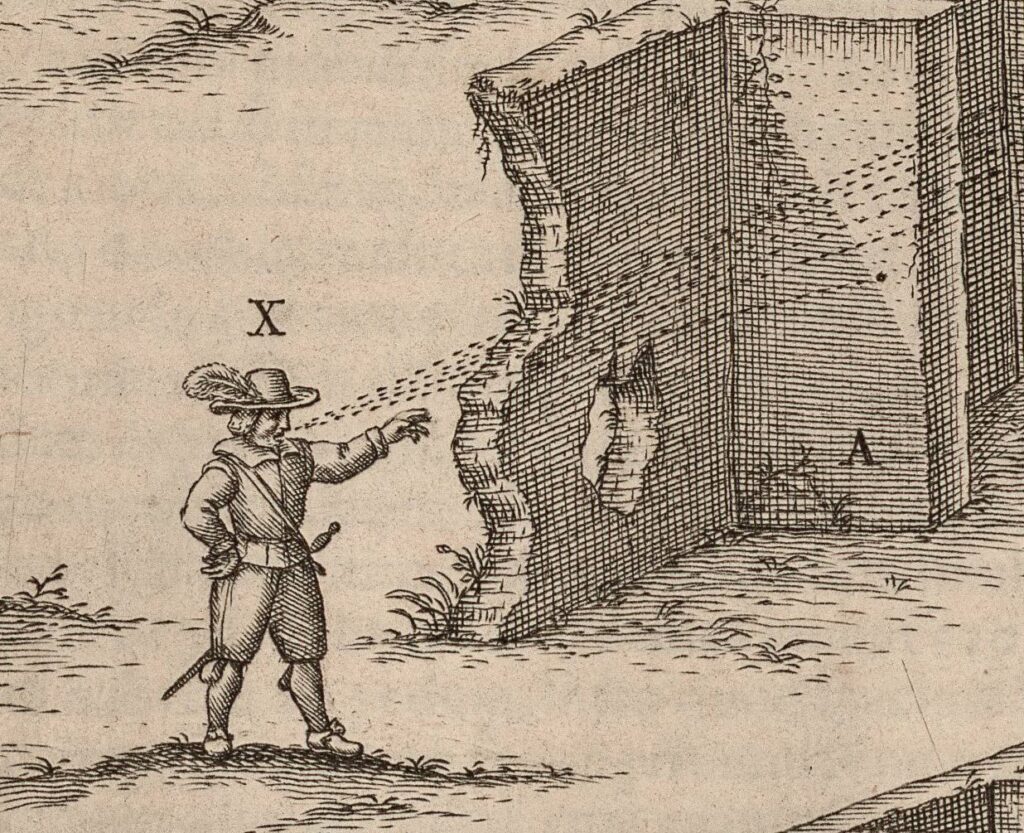
Starting in the top left, the viewer can see the God Pan chasing the nymph Echo, pointing to the mythical origins of the phenomenon of echoing.
Mirroring Pan’s hunt for the nymph Echo, the second figure is a well-dressed man who investigates a sound that is reflected on seven different walls. The sound is represented by dotted lines that hit the different walls of the architectural structure.
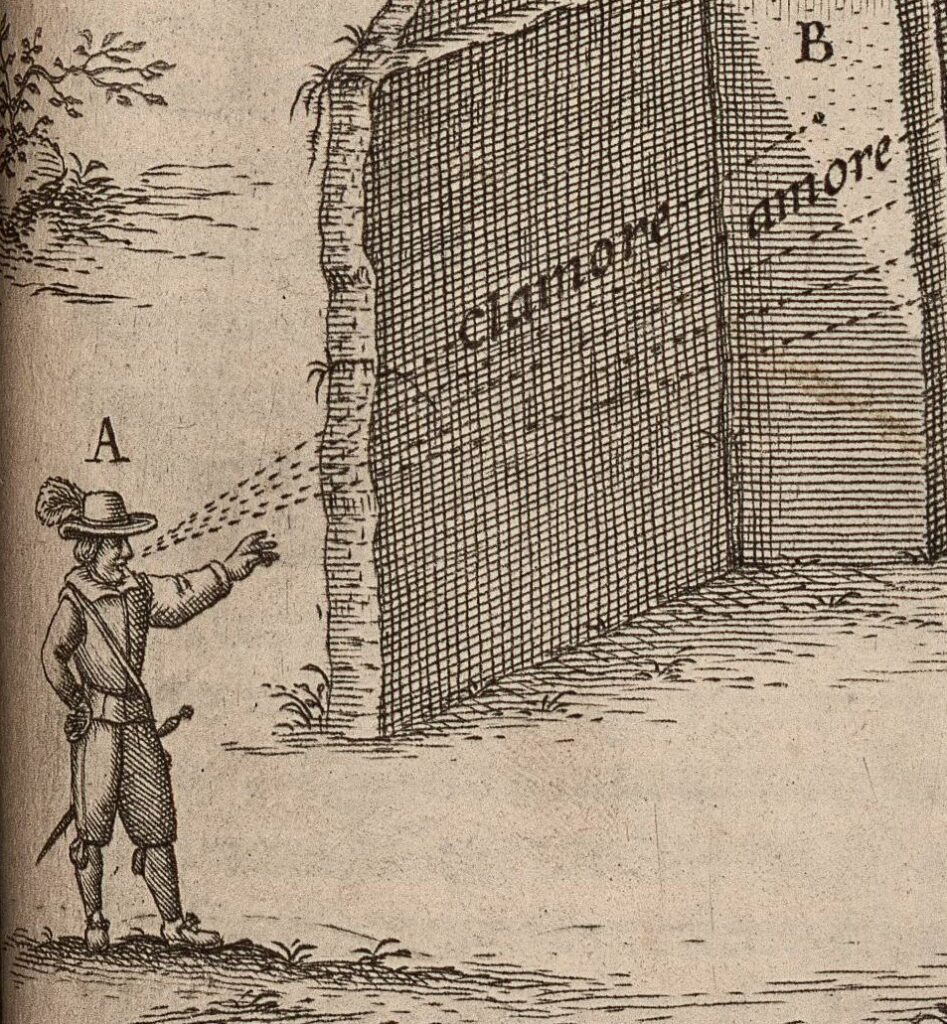
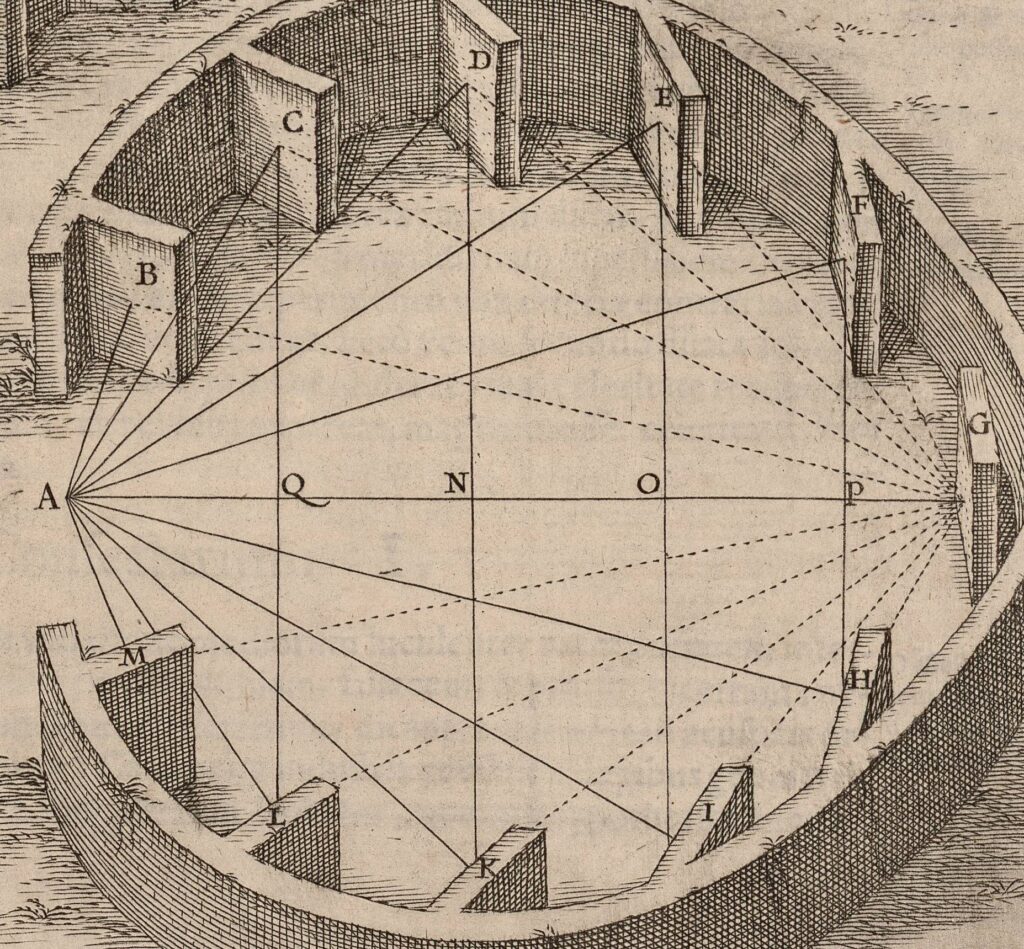
In the next scene, linguistic meaning is added to the echo. Kircher explains in the text how one can create echoes that reflect words in different parts. The man either speaks the word “clamore” or a phrase Kircher added in the accompanying text: “Tibi vero gratias agam quo clamore” (“How can I cry out my thanks for you”). The echo responds to these words with “clamore, amore, more, ore, re” (“exclamation, love, manner, words, deeds”).
In the last figure, the speaker who produces the sound has disappeared and the viewer is left with a diagram in a circular structure. Instead of broken down ruins, the architecture now looks finished. The letter “A” on the left designates the starting and ultimate focal point of the echoes. A single sound is reflected on eleven different walls before it ultimately returns to its source. The trajectory of the image can thus also be read as a progression from myth to a scientific diagram.
Sounds are present in a different way in this engraving from Giovanni Pietro Olina’s Uccelliera, a seventeenth-century manual for catching and taking care of birds. In the front is a consort of musicians playing on a trombones, cornetto, lute, viols, harp and harpsichord. In the distance, several musicians with wind instruments are standing around a table covered with music books. Birdcages with nightingales hang from the ceiling. The only one who seems to be silent is the dog in the middle. The scene represents one of the suggestions Olina gave in his book for making sure your nightingale sings well, namely join them in music making.
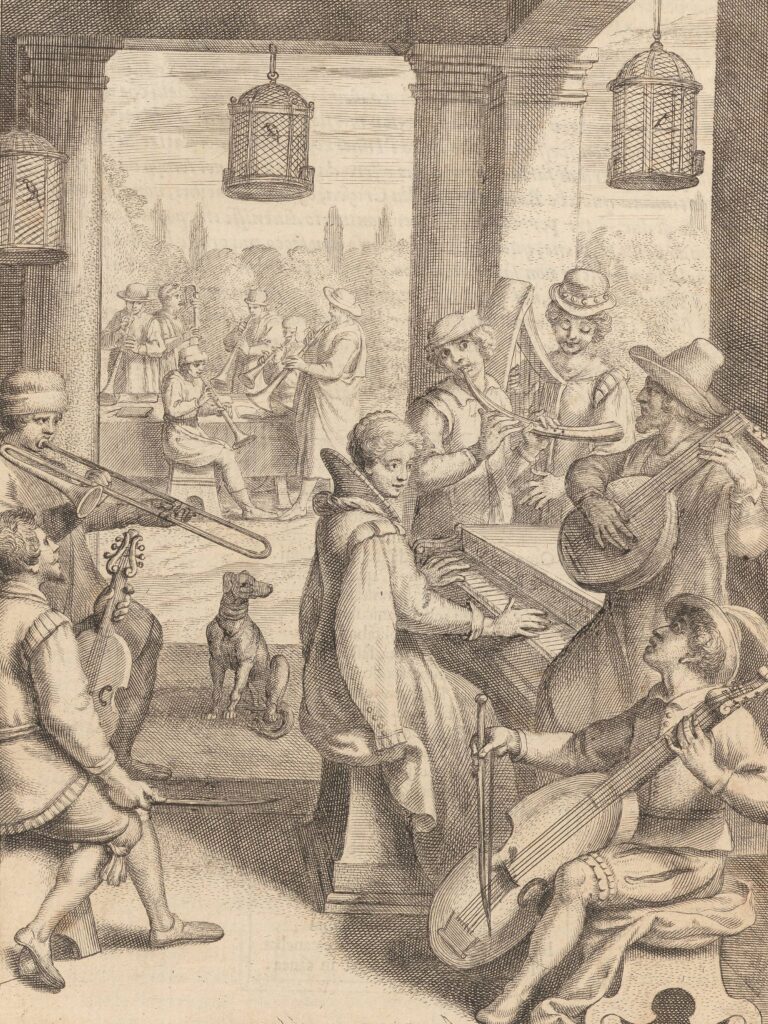
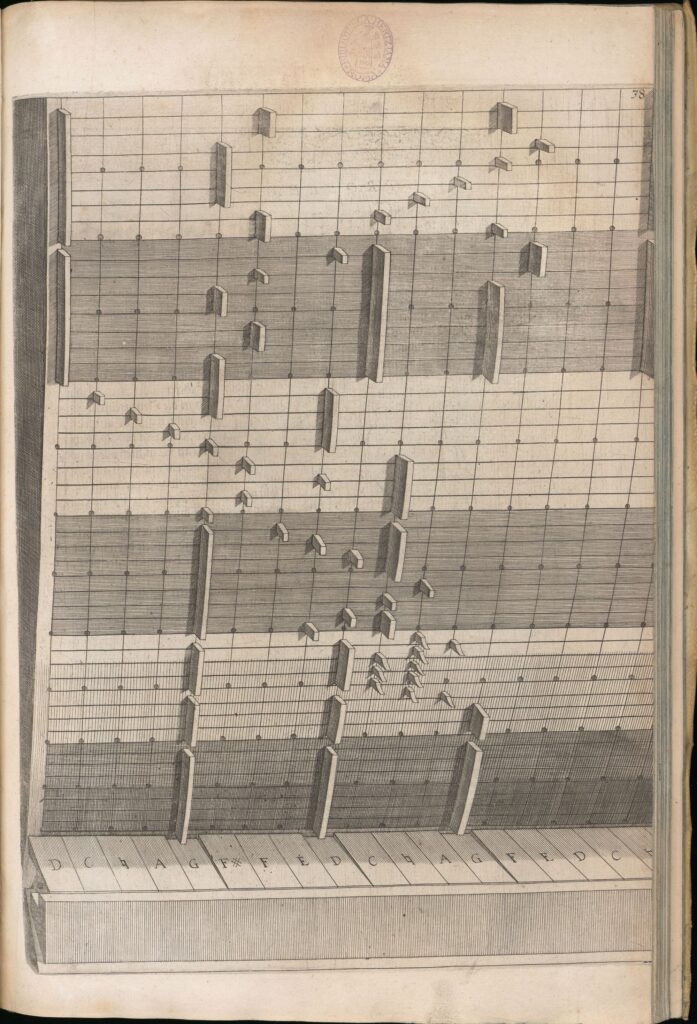
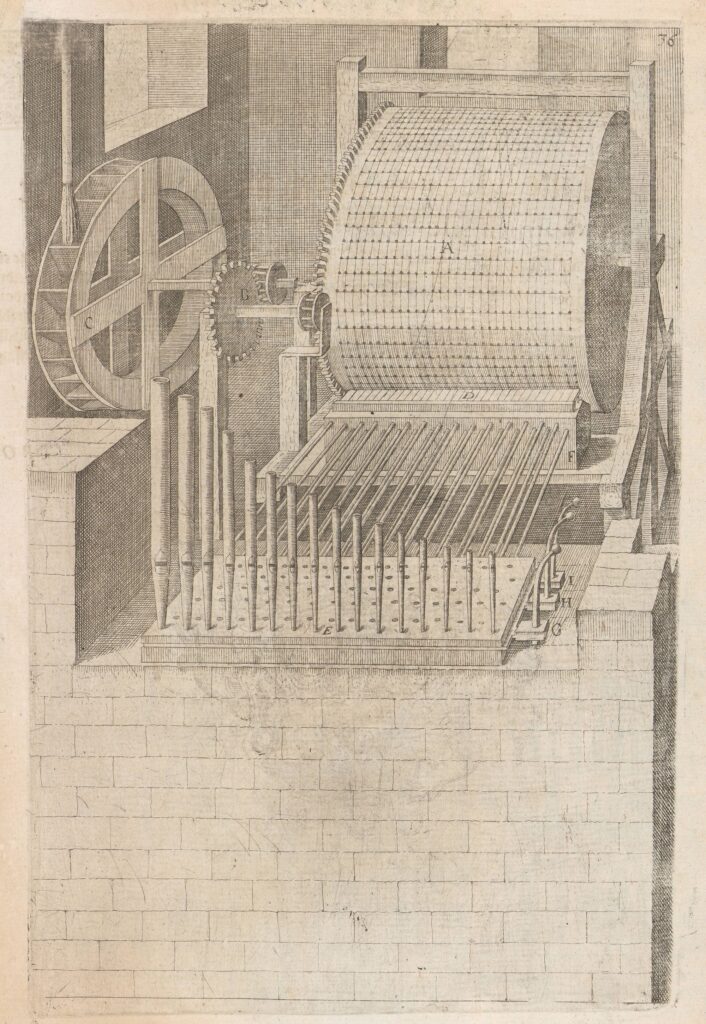
And finally, Salomon de Caus’ image from his engineering treatise gives us a glimpse into the operational power of a music machine, highlighting a rolling pin that strikes the different keys on a keyboard. This rotating wheel (called “Steinradt” in this German version of the book) is divided into a strict grid which represents the measure of the musical piece. The accompanying text gives the reader instructions how to build such a device, but the image contains little technical details. Rather it gives an overwhelming impression to the readers of this wondrous device.
In another image, De Caus gives a more complete impression of the music machine operated by water. The keys of the keyboard in turn are connected to organ pipes. Many of such machines were actually built around 1600 in grottoes and gardens across Europe. And reconstructions of De Caus’ machines such as the one in Kloster Michaelstein in Germany give a glimpse of the sounds captured in the page.
Sources:
- Barbaro, Daniele Matteo Alvise. La pratica della perspettiva: opera molto utile a pittori, a scultori, & ad architetti. Venice: Appresso Camillo and Rutilio Borgominieri, 1569. Gh-BAR 587-1690 raro VI [Kubikat; Digitized Version]
- De Caus, Salomon. Von Gewaltsamen bewegungen: Beschreibung etlicher, so wol nützlichen alß lustigen Machiner beneben Unterschiedlichen abriessen etliher Höllen od. Grotten vnd lust Brünne[n]. Frankfurt: Pacquart, 1615. Gh-CAU 6905-2150 raro VIII [Kubikat; Digitized Version]
- Kircher, Athanasius. Musurgia Universalis Sive Ars Magna Consoni Et Dissoni.In X. Libros Digesta. Rome: Corbelletti, 1650. Zs-KIR 1051-2500 raro VIII [Kubikat; Digitized Version]
- Niceron, Jean-François. La Perspective Curieuse Ou Magie Artificiele Des Effets Merveillevx. De L’Optique … .Paris: Billaine, 1638. Gh-NIC 2067-2380 raro VIII [Kubikat; Digitized Version]
- Olina, Giovanni Pietro. Uccelliera. Rome: Angelo de Rossi, 1684. Hm 5715-2840 raro V [Kubikat; Digitized Version]
- Virloys, Roland le. Dictionnaire D`Architecture, Civile, Militaire et Navale, Antique, Ancienne et Moderne, et de tous les Arts et Métiers qui en dépendent. 3 vols. Paris: Libraires Associés, 1770. Ab 30-3700 raro VI [Kubikat; Digitized Version]
- Von Sandrart, Joachim. L’ Academia Todesca della Architectura, Scultura & Pittura: Oder Teutsche Academie der Edlen Bau-, Bild- und Mahlerey-Künste. Nürnberg: Miltenberger 1675. Gh-SAN 1595-2750/1 1-2 raro VIII [Kubikat; Digitized Version]
Further reading:
- Clarke, Joseph. Echo’s Chambers: Architecture and the Idea of Acoustic Space. Pittsburgh, PA, University of Pittsburgh Press, 2021.
- Dupré, Sven. “Visualization in Renaissance Optics: The Function of Geometrical Diagrams and Pictures in the Transmission of Practical Knowledge.” In Transmitting Knowledge: Words, Images and Instruments in Early Modern Europe, edited by Sachiko Kusukawa and Ian Maclean, 11-39. Oxford: Oxford University Press, 2006.
- Massey, Lyle. Picturing Space, Displacing Bodies: Anamorphosis in Early Modern Theories of Perspective. University Park, PE: Pennsylvania State University Press, 2007.
- Mayer-Deutsch, Angela. “Early Modern Images of Musical Automata: On Athanasius Kircher’s Trompe-l’Oreille Contemplations in the Quirinal Gardens in Rome.” In The Technical Image: A History of Styles in Scientific Imagery, edited by Horst Bredekamp, Vera Dünkel and Birgit Schneider, 157–65. Chicago: University of Chicago Press, 2015.
- Oy-Marra, Elisabeth, Klaus Pietschmann, Gregor Wedekind and Martin Zenck, eds. Intermedialität von Bild und Musik. Paderborn: Wilhelm Fink, 2017.